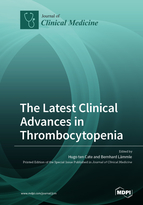The Latest Clinical Advances in Thrombocytopenia
A special issue of Journal of Clinical Medicine (ISSN 2077-0383). This special issue belongs to the section "Hematology".
Deadline for manuscript submissions: closed (31 January 2021) | Viewed by 112731
Special Issue Editors
Interests: vascular medicine; thrombosis; coagulation; atherothrombosis; DIC
2. Senior Professor, Center for Thrombosis and Hemostasis, University Medical Center Mainz, Johannes Gutenberg University, Mainz, Germany
3. Visiting Professor, Haemostasis Research Unit, University College London, London, UK
Interests: Thrombotic thrombocytopenic purpura; thrombotic microangiopathies; ADAMTS13; Hemostasis disorders; thrombotic disorders; Hematology
Special Issue Information
Dear Colleagues,
Platelets are critical elements in the blood stream, supporting hemostasis as well as performing even more complex tasks within networks of biological (immunity) and pathophysiological processes, such as cancer and ischemia/reperfusion injury. Changes in the number (and function) of platelets may have a substantial impact on any of these processes. The “simple” finding of a reduced platelet count (thrombocytopenia) has a history (origin) and a consequence (e.g., bleeding). The origin of thrombocytopenia can be unclear (idiopathic), can depend on associated illness (e.g., DIC, HIT, TTP) with a different etiology depending on the illness (related to production, clustering, immune depletion, etc.), and can also be acquired (e.g., during extracorporeal circuits, such as “ECMO”). Currently, the COVID-19 pandemic is also characterized by a reduced platelet count, although it is less severe than in other diseases, and the overall patient phenotype seems thrombotic rather than hemorrhagic as in other virus infections, such as dengue. Thus, there many possible causes for thrombocytopenia, and these are, quite often, poorly characterized. Because the clinical question is always whether or not the platelet deficit has consequences for the patient, it is important and timely as well (e.g., COVID-19) to discuss this topic in a Special Issue.
Based on your expertise, we ask you to contribute an article to this Special Issue.
Prof. Dr. Hugo ten Cate
Prof. Dr. Bernhard Lämmle
Guest Editors
Manuscript Submission Information
Manuscripts should be submitted online at www.mdpi.com by registering and logging in to this website. Once you are registered, click here to go to the submission form. Manuscripts can be submitted until the deadline. All submissions that pass pre-check are peer-reviewed. Accepted papers will be published continuously in the journal (as soon as accepted) and will be listed together on the special issue website. Research articles, review articles as well as short communications are invited. For planned papers, a title and short abstract (about 100 words) can be sent to the Editorial Office for announcement on this website.
Submitted manuscripts should not have been published previously, nor be under consideration for publication elsewhere (except conference proceedings papers). All manuscripts are thoroughly refereed through a single-blind peer-review process. A guide for authors and other relevant information for submission of manuscripts is available on the Instructions for Authors page. Journal of Clinical Medicine is an international peer-reviewed open access semimonthly journal published by MDPI.
Please visit the Instructions for Authors page before submitting a manuscript. The Article Processing Charge (APC) for publication in this open access journal is 2600 CHF (Swiss Francs). Submitted papers should be well formatted and use good English. Authors may use MDPI's English editing service prior to publication or during author revisions.
Keywords
- thrombocytopenia
- platelet function
- thrombosis
- bleeding
- malignancy
- virus
- DIC
- TTP
- HIT
- extracorporeal circulation








